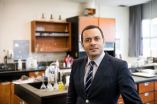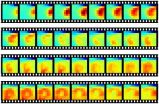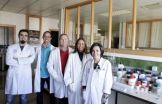(Press-News.org) ITHACA, N.Y. – Like mobsters following strict orders, newly engineered molecules called "ubiquibodies" can mark specific proteins inside a cell for destruction – a molecular kiss of death that is paving the way for new drug therapies and powerful research tools.
Led by professor Matthew DeLisa, chemical engineers at Cornell University have developed a new type of antibody, called a "ubiquibody," which is an antibody fragment they have inserted into the natural process known as the ubiquitin-proteasome pathway (UPP). Their work appears in the March 16 issue of the Journal of Biological Chemistry and is highlighted in an analysis piece in the publication SciBX.
Study: http://www.jbc.org/content/early/2014/01/28/jbc.M113.544825
The UPP is the natural cellular pathway, or process, by which a cell gets rid of proteins it doesn't want anymore. A doomed protein gets tagged with a chain of a protein called ubiquitin, which is like a molecular sign that reads, "destroy me." The ubiquitin-tagged protein gets sent to the cell's proteasome – the cell's trash compactor – which breaks the protein into component amino acids.
DeLisa and colleagues hypothesized that this common process could be harnessed as a simple, tunable way to eliminate certain target proteins in a cell without having to mess with the genome to delete the protein using standard genetic engineering tools.
They did it by taking advantage of the modular nature of the UPP, which involves three enzymes called E1, E2 and E3. They modified a particular E3 enzyme called CHIP, giving only that part of the pathway a makeover.
They removed CHIP's natural binding domain, replacing it with an engineered binding protein – in this case an antibody fragment – that was created in the lab. The idea was to empower CHIP to put ubiquitin chains on any target, guided by the homing capabilities of the antibody fragment to seek out and bind to its specific target. They named the entire re-engineered molecule with the modified CHIP enzyme a ubiquibody.
To prove their concept, the researchers modified CHIP with a binding protein that targets the enzyme beta-galactosidase. They introduced DNA that encoded for their beta-galactosidase target into a human cell line, along with DNA that encoded their ubiquibodies with a binding protein for the beta-galactosidase enzyme. Sure enough, beta-galactosidase levels went down in the presence of the corresponding ubiquibodies.
"Our ability to redirect whatever protein you want to the proteasome is now made possible simply by swapping out different binding proteins with specificity for targets of interest to the researcher," DeLisa said.
Ubiquibodies could provide a powerful way to not only completely delete a protein from a cell to study that protein's effects, but to discover what happens if, say, only 50 percent of that protein is deleted. Current gene knockout technologies are all or nothing, DeLisa said. Ubiquibodies could fine-tune research around protein deletion or reduction.
The technology could also prove useful for future drug therapies. In a cancer cell in which a certain protein has been identified as contributing to the disease, the ubiquibody could reduce or eliminate the protein from within by targeting that specific protein only, DeLisa said.
The therapeutic potential for ubiquibodies is being explored further in DeLisa's lab, with experiments on target proteins known to be present in diseases including Alzheimer's, cancer and Parkinson's.
INFORMATION:
First author of the paper, "Ubiquibodies, Synthetic E3 Ubiquitin Ligases Endowed with Unnatural Substrate Specificity for Targeted Protein Silencing," is Alyse Portnoff, a former Cornell biomedical engineering graduate student. Other co-authors are Erin Stephens, a graduate student in the field of biochemistry, molecular and cell biology; and Jeffrey Varner, professor of chemical and biomolecular engineering.
The work was supported by the National Institutes of Health.
New molecules doom proteins with kiss of death
2014-03-05
ELSE PRESS RELEASES FROM THIS DATE:
Some metallic toys and low-cost jewelry present health risks for young children
2014-03-05
This news release is available in French.
We know that babies and young children often put non-food items in their mouths, a behaviour that occasionally leads to swallowing of foreign objects. Metallic toys and low-cost jewelry often contain toxic substances such as lead and cadmium. Do these objects present a health risk for young children?
To answer this question, Gérald J. Zagury, a professor in the Department of Civil, Geological and Mining Engineering at Polytechnique Montréal, and Mert Guney, a former doctoral student under Professor Zagury's supervision, ...
Half of pregnant women are passive smokers, due above all to their partners
2014-03-05
As shown in a study carried out by researchers at 13 research centres in Asturias, Gipuzkoa, Sabadell and Valencia, over half of non-smoking pregnant women, 55%, are passive smokers. These women are under the effect of tobacco smoke to a considerable extent because a member of the household, their partner in particular, smokes at home. The result of the study has been published in the journal Science of the Total Environment.
Within the INMA project that studies childhood and the environment, research has been carried out into the extent to which non-smoking pregnant ...
Sulphur haunts the ghost wreck
2014-03-05
Scientists from the same team have previously reported large amounts of sulphur and iron accumulation in the warship Vasa. In that study, the scientists found an outbreak of acidity and sulphate salts on the surface of the hull and other wooden objects.
'This is the result of biological and chemical processes that occur naturally in low-oxygen waters and in sediments,' says Yvonne Fors from the Department of Conservation at the University of Gothenburg and one of the scientists behind the article.
However, even if sulphur and iron accumulation is commonly occurring ...
Plumes in the sleeping avian brain
2014-03-05
This news release is available in German.
When we drift into deep slow-wave sleep (SWS), waves of neuronal activity wash across our neocortex. Birds also engage in SWS, but they lack this particular brain structure. Researchers from the Max Planck Institute for Ornithology in Seewiesen, Germany together with colleagues from the Netherlands and Australia have gained deeper insight into the sleeping avian brain. They found complex 3D plumes of brain activity propagating through the brain that clearly differed from the two-dimensional activity found in mammals. These ...
New technique allows frequent water quality monitoring for suite of pollutants
2014-03-05
Researchers from North Carolina State University have developed a new technique that uses existing technology to allow researchers and natural resource managers to collect significantly more information on water quality to better inform policy decisions.
"Right now, incomplete or infrequent water quality data can give people an inaccurate picture of what's happening – and making decisions based on inaccurate data can be risky," says Dr. François Birgand, an assistant professor of biological and agricultural engineering at NC State and co-author of a paper describing the ...
Copied from nature: Detecting software errors via genetic algorithms
2014-03-05
This news release is available in German.
According to a current study from the University of Cambridge, software developers are spending about the half of their time on detecting errors and resolving them. Projected onto the global software industry, according to the study, this would amount to a bill of about 312 billion US dollars every year. "Of course, automated testing is cheaper", explains Andreas Zeller, professor of Software Engineering at Saarland University, as you could run a program a thousand times without incurring any charges. "But where do these ...
New findings on neurogenesis in the spinal cord
2014-03-05
Research from Karolinska Institutet in Sweden suggests that the expression of the so called MYC gene is important and necessary for neurogenesis in the spinal cord. The findings are being published in the journal EMBO Reports.
The MYC gene encodes the protein with the same name, and has an important role in many cellular processes such as proliferation, metabolism, cell death and the potential of differentiation from immature stem cell s to different types of specialized cells . Importantly it is also one of the most frequently activated genes in human cancer.
Previously ...
Barbie could dampen a young girl's career dreams
2014-03-05
Although the marketing slogan suggests that Barbie can "Be Anything," girls who play with this extremely popular doll see fewer career options available to themselves compared to boys. So say Aurora Sherman of Oregon State University and Eileen Zurbriggen of the University of California, Santa Cruz, who conducted one of the first experiments on how playing with fashion dolls influences girls' perceptions about their future occupational options. The findings, which the psychologists describe as "sobering," are published in Springer's journal Sex Roles.
Sherman and Zurbriggen ...
Technique patented that opens the door to the development of new drugs against osteoporosis
2014-03-05
This news release is available in Spanish.
Scientists from the University of Granada (UGR) have opened the door to the development of new drugs against osteoporosis, one of the most common chronic illnesses in the world, especially among women 65 or over.
The researchers, from the University of Granada's Department of Physio-Chemistry, have patented a new methodology that allows specialists to measure – none-invasively and in real time – the concentration of phosphate ions inside living cells. The scientific importance of measuring phosphate ions is based precisely ...
Banana plant fights off crop's invisible nemesis: Roundworms
2014-03-05
The banana variety Yangambi km5 produces toxic substances that kill the nematode Radopholus similis, a roundworm that infects the root tissue of banana plants – to the frustration of farmers worldwide. The finding bodes well for the Grande Naine, the export banana par excellence, which is very susceptible to the roundworms.
The parasitic nematode Radopholus similis is the invisible nemesis of the banana plant, says Professor Dirk De Waele (Laboratory for Tropical Crop Improvement, KU Leuven), a co-author of the study: "This roundworm infects banana crops worldwide. The ...








